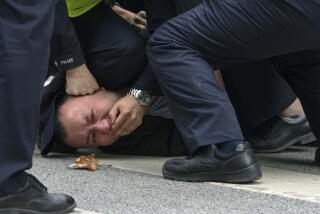Beijing Says Ethnic Rioting Kills 22 : China: Two days of clashes erupt in a western Muslim region. Official media put blame on ‘counterrevolutionaries.’
- Share via
BEIJING — Two days of anti-Chinese rioting by ethnic minority protesters in western China has left 22 people dead and at least 19 injured, according to an official report that reached Beijing on Sunday.
State-run television in the Xinjiang region reported Saturday that masses of people in the town of Baren, about 100 miles from the Soviet border, killed six police officers April 5 as security forces tried to suppress a demonstration.
The next day, an armed battle with police left 15 protesters and one local official dead, according to the Chinese television report. The report became available in Beijing from the British Broadcasting Corp., which has a service that monitors foreign radio and television broadcasts.
According to the Xinjiang television station, the trouble was instigated by a “counterrevolutionary organization” that “conspired to oppose the Chinese Communist Party and the people’s government.”
Baren, the town where the violence occurred, is located in Akto County in a so-called autonomous prefecture primarily populated by Kirghiz, a Muslim ethnic group. Such autonomous areas theoretically ensure the political rights of minorities, but, in practice, power remains in the hands of ethnic Chinese loyal to the Communist Party and the central government.
The town lies about 30 miles south of the old Silk Road city of Kashgar, which is mostly populated by Uighurs, another Muslim minority.
Just across the Soviet border is a primarily Kirghiz republic. The report did not specify the ethnicity of the protesters but implied that most were Kirghiz.
There is a history of centuries of conflict between Muslim groups in Xinjiang, which now make up only about half the province’s 14 million people, and the dominant ethnic Chinese.
In recent months, various reports have indicated a rise in tensions, and authorities have publicly expressed concern that rising ethnic nationalism in the Soviet Union may spill across the border.
The Xinjiang television report called the early April incident “a counterrevolutionary armed rebellion” and charged that organizers had “weapons and ammunition ready for carrying out the rebellion.”
Trouble began during a festival April 5, the report said. Without providing details, it said counterrevolutionary “ruffians” forced “ill-informed masses to make trouble.”
As the confrontation escalated, a crowd trapped local officials and paramilitary police inside the courtyard of the town government building, the report said.
“They also frenziedly stopped and attacked the public security personnel who went to perform their duty, robbed them of their weapons and killed six armed police officers and fighters, injured 13 others and destroyed four police vehicles,” the report said.
Fighting continued the next day, with insurgents firing guns and hurling bombs at police and officials, wounding three police officers, the report said. Security forces then “gave chase to the small number of ruffians who had guns and who tried to resist, killing 15.” During this fighting, an ethnic Uighur official working for the government also was killed and three more people were injured, the report said.
Rumors of an incident about 30 miles from Kashgar in which as many as 50 people were said to have died have circulated in Xinjiang for nearly two weeks, according to foreign travelers returning from the region. It appeared likely that the clash in Baren is the incident that gave rise to these reports.
While the television report denied that religion was a factor in the rioting, the earlier unconfirmed reports indicated that the confrontation was somehow related to restrictions on the building of a mosque.
The official Xinjiang Daily reported in March that Communist authorities had decided that existing mosques in the region were “sufficiently numerous to care for the believers’ needs” and that all new construction was thus to be “subject to prior authorization.”
Although religion was violently suppressed in China during the 1966-76 Cultural Revolution, a moderate resurgence, especially in minority areas, was allowed in the 1980s. If Beijing now finds it necessary to violently suppress minority demands in China’s far west, it could damage its relations with Muslim countries at a time when its ties with the industrial democracies are already suffering due to last year’s bloody suppression of student protests in Beijing.
More to Read
Sign up for Essential California
The most important California stories and recommendations in your inbox every morning.
You may occasionally receive promotional content from the Los Angeles Times.













